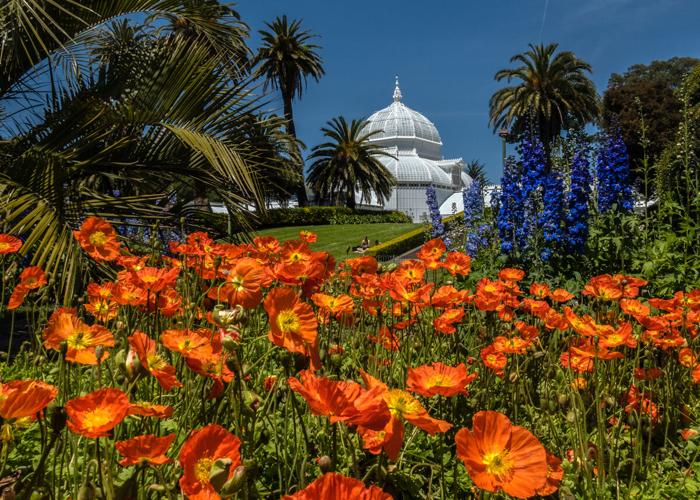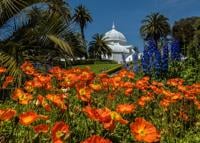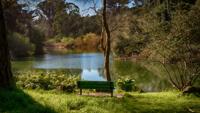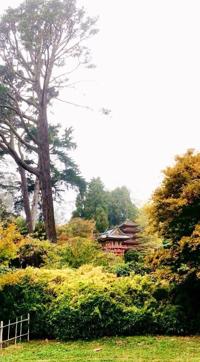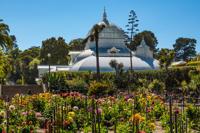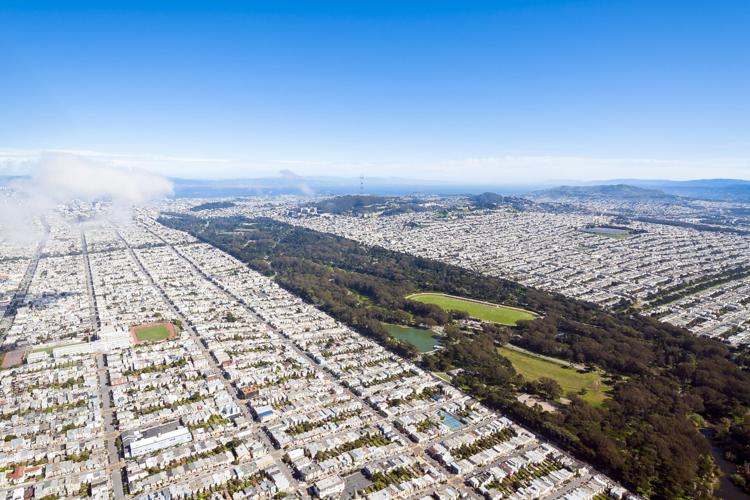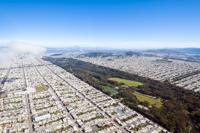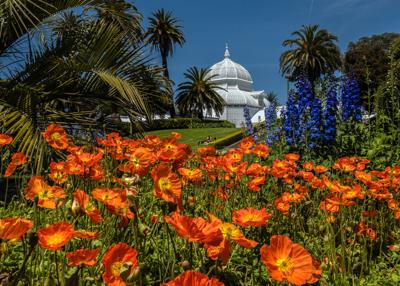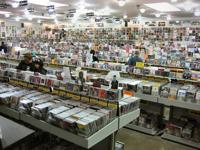As is surely the case for so many other San Francisco natives, Stuart Watts’ earliest memories are set in Golden Gate Park. He remembers playing at the old Children’s Park, before its remodel, and getting to know the shaggy bovines at the Bison Paddock. He fondly recalls watching the Model Yacht Club’s miniature boats zip by on Spreckels Lake and the comfort he felt when the always-dependable afternoon fog rolled over the avenues during his soccer practices at Lindley Meadow.
“In each part of my life, I felt different about the park — I felt like the park and I almost communicated differently,” Watts said. “But all in a positive way, almost like we were growing together.”
A fifth-generation San Franciscan, Watts’ familial ties to the city predate the park’s creation. And in his lifetime alone, Watts has witnessed several significant transformations: the rebuilding of the Conservatory of Flowers after its wreckage in a 1995 windstorm, the reopening of the rebuilt de Young Museum in 2005, and the unveiling of the decade-long remodel of the Academy of Sciences in 2008.
This year is a particularly significant one for the park: 2020 marks its 150th anniversary. To honor the occasion, SF Weekly spoke to 13 individuals with special connections to the city’s 1,017 acre shared backyard.
Overwhelmingly, those who shared their stories of the park spoke less about the numerous concerts and events that attract tourists and visitors. Indeed, several of the San Francisco natives interviewed for this story criticized what they see as the corporatization of the park — pointing specifically to the price of admission for the annual Outside Lands music festival, which can run well north of $300 — saying they wished to preserve the sanctity of the park by keeping it as accessible as possible.

Photo courtesy of Dennis Minnick
Those who share this view are not mourning the pandemic-related cancellations of Outside Lands or the grand festivities planned for the park’s anniversary year. (Two San Francisco natives said long-time Golden Gate Park superintendent John McLaren would be turning in his grave at the sight of the gargantuan, nonoperational ferris wheel currently seated at the edge of the Music Concourse.)
In fact, San Francisco native and local historian Woody LaBounty observed that the restrictions imposed by the COVID-19 pandemic have allowed San Franciscans to rediscover the park’s original intent.
“I go to the park and I see families barbecuing and sitting under trees and picnicking and playing frisbee and using the park the way it was originally intended, as a refuge,” LaBounty said. “To escape from urbanity.”
Sands of Time
Had San Francisco city officials listened to Central Park landscape architect Frederick L. Olmsted, Golden Gate Park would be located in the eastern half of the city, under Sutro Tower. (Alternatively, had the “Big Four” millionaires gotten their way, San Francisco would now have a mile-long horse racetrack inside the park).
San Francisco city officials, however, were adamant that a park would be constructed on the western side of the city — despite serious concerns that the site was unsuitable for urban development. These doubts were not unfounded; after all, in the 1860s, the site was not the natural oasis it is today, but rather an expanse of windswept, rolling sand dunes known as the “Outside Lands.”
Though Olmsted was initially selected to head the project, he said building a park on sand dunes would never work. So city officials chose 24-year-old William Hammond Hall to design Golden Gate Park instead.
Landscape architect Doug Nelson, who has done extensive research and work on Golden Gate Park, says that Hall, who was not college educated, “was a brilliant, genius kind of person.”
And, of course, the park was a success, thanks in large part to its reliance on available resources and the use of existing topography instead of flattening the sand dunes.
The park was also immediately popular upon its opening in April of 1870, initially drawing hundreds of visitors during the weekdays and thousands on the weekends.
Though it was a feat of ingenuity, Hall’s original plan merely consisted of a sketch he had done of the park. Detailed construction documents recording how the park was built largely don’t exist.
So in the 1990s, Nelson acted as the primary author of the park’s first comprehensive master plan, created to guide the development and renovation of the park. The plan, which is still in use, solidified the park as a historic resource worthy of preservation.
Nelson and others who have worked on the park, like architect Debbie Cooper, remember the experience fondly. Cooper, who led the 1995–2003 restoration of the Conservatory of Flowers, said she loved visiting the worksite, recalling that each time she went she would get an exclusive, gardener-led tour of all of the orchids in bloom.
Cooper recalled other fond memories: constructing a temporary greenhouse made of shrink wrap and fitted with built-in irrigation, lighting and heating to protect a century-old philodendron; watching the butterfly release in the west wing of the building upon the Conservatory’s reopening; and the the day the Conservatory’s dome, constructed at ground level, was lifted and reinstalled.
“Everything fit just right,” Cooper recalled. “It was like the crown being placed on top of the building.”
Child’s Play
For San Franciscans like LaBounty who grew up in the Sunset or the Richmond Districts, Golden Gate Park served as a 1,017 acre backyard. And in the ’70s, at a time when the city was darkened by the “Zebra” murders and the Zodiac Killer, the park served as a safe haven.
“I was probably the last generation of the free range children that sort of ran around without too much supervision,” LaBounty says.
Other San Francisco natives remember countless family outings in the park as well as times spent wandering the park without parental supervision.
San Francisco native Lorna Carroll recalls the time she followed a group of kids into the park when she was around four years old. At the time, her dad sold vacuum cleaners out of a utility truck that had a loudspeaker, and he drove it around the streets shouting her name until she was found.
Having adventures and getting in trouble was a common thread that wove together most childhoods spent in the park. There was the illegal rope swing that was removed by gardeners and then repeatedly rehung in defiance, and pennies thrown at live alligators at the Academy of Sciences.
There were also stories of shocking things that went on at Stow Lake and Speedway Meadow — stories which were not divulged on the record.
And then there was the de Young Museum back when it was completely free. Long-time museum educator Sheila Pressley says she’s heard countless tales from San Francisco natives who recall running through the museum and visiting each week just to see the museum’s mummy.
As a child, the park was just experienced differently. Watts remembers feeling like the park was endless, as if “you couldn’t even reach a corner if you tried.”
After spending much of her life in the city, Carroll moved out of San Francisco. A few years ago, while on a trip with friends, she returned to Golden Gate Park for the first time in several years.
“I still felt the same way — kind of a homesickness,” she recalls. “That could be childhood memories. It’s a place you love and you love it when you go back.”
Golden Gate Gardeners

Photo by Grace Z. Li
After years spent exploring the park, San Francisco natives can easily recount their favorite hidden treasures — from secret histories to tucked-away meadows. But perhaps no one has more behind-the-scenes knowledge than George Foehr, who was once a third-generation Golden Gate Park gardener.
The Foehr family’s green thumb is evident in the park. Just look at the rhododendron dell, a feature of the park for over 70 years, which was first planted by Max Foehr.
In a fated encounter, Max, a German immigrant, crossed paths with long-time park superintendent John McLaren. The two men shared an interest in horticulture (Foehr’s relatives were gardeners for German royals). So McLaren invited Max to work for him in Golden Gate Park.
Max Foehr would go on to work as a gardener in the park for 47 years. Over that time he maintained a close relationship with McLaren.
“He was one of the few gardeners in the park that would talk back to ‘the old man,’ which is what they called McLaren,” says George Foehr, Max’s grandson.
George, who grew up on stories of the park, says McLaren would monitor gardeners from the green Packard he drove. To reward employees for doing a good job, “he’d pull his car over and have you come over to the car and do a shot of scotch whisky,” George says.
McLaren was a nature purist with a very particular vision for the park, a vision that was free of buildings and definitely free of statues. When he was forced to put statues in the park, McLaren would hide them with strategically placed shrubs and vines. Ironically, a statue of McLaren now stands in the park, though it is appropriately tucked away.
“There’s no plaque, there’s no name and it’s just him looking down at a pinecone,” Watts says of McLaren’s statue. “It’s reminded me every time I go on my hikes about what John McLaren wanted the space to be — he wanted it to be wild.”
McLaren later became a mentor to Max’s son Frank, who was born six days after the 1906 San Francisco earthquake. Ironically, for a short time after being displaced by the temblor, Frank was raised in a park — in a tent in Hamilton Square.
At the age of 14, Frank began working at Golden Gate Park as a surveyor’s assistant. Later on, after he was trained as a landscape architect, Frank landscaped both the Palace of Fine Arts and Carl Larsen Park, and he also laid out the entirety of McLaren park. He was recognized for his work with awards for beautifying the state and the country.
Frank was also close friends with the Hagiwara family who oversaw the Japanese Tea Garden for many years.
When the Hagiwara family was sent to Japanese Internment Camps during World War II, George says his father tried to protect the tea garden as much as he could, but it was ultimately pilfered. There have since been efforts to restore elements of Japanese culture to the garden lost during the war.
Ultimately, McLaren chose Frank to succeed him as park superintendent. This was Frank’s final position in his nearly 50-year career serving the park.
In the 1970s, George became the third generation of Foehrs to work in the park. For a brief time, George was in charge of the native plant section in the Botanical Gardens. And though he later left the park, he continued to manage landscapes for a living — designing gardens for private estates.
“Some of my kids said I was born with sap in my veins,” he laughs.
The Band Plays On
If you have ever enjoyed a concert in the park, you have Frank Foehr to thank.
The year was 1967, and hordes of young people had descended on San Francisco for the Summer of Love, converging in the Haight-Ashbury and gathering on Hippie Hill.
“My dad was quite concerned about this influx of young people coming into the city,” recalls George Foehr, who was 15 at that time. “I remember him at the dinner table talking to my mom saying, ‘Mary, these kids are coming to this city, they don’t have shoes or shirts on their back.’”
Frank, who leaned conservative, was concerned about the drug use going on at the time, his son said.
“He just felt sorry for the kids,” George says. “They’re hanging out in the park, they don’t have a penny in their pocket.”
Meanwhile, there was a petition going around to have a concert in the park (George thinks the performers in demand might have been The Grateful Dead or Jefferson Airplane).
Despite his aversion to some of the trappings of hippie culture, Frank was in support of the idea, as he saw the concert as a positive outlet. So he went before the park commission and argued in favor of having a concert in Golden Gate Park, “and after that,” George says, “it’s history.”
Since then, annual concerts have become a staple of Golden Gate Park. Outside Lands, which brings in hundreds of thousands of attendees, has been an annual occurrence since 2008 — save for this year.

Photo courtesy of Dennis Minnick
Yet it’s Hardly Strictly Bluegrass that seems to have captured the hearts of so many San Franciscans, especially because the annual concert remains free and accessible to all, unlike Outside Lands.
“Hardly Strictly is anybody — hippies from the ’70s, kids who’ve never been to concerts, and it’s a cross-section of blue collar, white collar, every kind of person,” says Michael Durand, editor and publisher of the Richmond Review and Sunset Beacon newspapers.
As a musician himself, Durand is particularly fond of the annual Flower Piano event — a 12-day period where 12 pianos are placed around the Botanical Garden for public use.
There’s one piano that sits surrounded by redwood trees. That’s Durand’s favorite spot.
“I’d play there for hours,” he says.
Amazing Races & Good Games
No picture of the park is complete without a discussion of the countless ways visitors and locals alike make use of it to exercise and stay active. And the iconic annual Bay to Breakers event, which merges fitness and festivity, has yielded many cherished memories.
As the name implies, the century’s old race starts at the San Francisco Bay and ends at the breakers of Ocean Beach, with much of the course weaving through Golden Gate Park.
San Francisco native Marguerite Rodigou ran the race for several years in the ’80s. She remembers it as a treasured family event that always concluded at her parents’ house in a post-race carbo-loading feast of beer and pancakes.
Rodigou says one of her all-time favorite memories of the race is the final two-and-a-half mile stretch where participants get to see “the best parts” of Golden Gate Park.
After Hayes Street, runners, power walkers, and meandering day drinkers arrive at JFK Drive “and you cruise through the park,” past the Conservatory of Flowers and then the de Young Museum and the Bison Paddock. And, eventually, those who finish arrive at the beach.
“It really is magical, that last two-and-a-half miles,” Rodigou says.
Long-time San Francisco resident Nancy DeStefanis says she used to train for the Bay to Breakers by running the path around Stow Lake three times. In 1976, when she ran the race with three friends, a photographer snapped a photo of them that ended up running as a full page in Sunset Magazine.
These days, DeStefanis prefers to walk the perimeter of the lake.
“I know I’m doing well when I’ve done my three walking laps,” she says.
San Francisco native Dennis Minnick, who grew up in the Haight-Ashbury and spent a lot of time in Golden Gate Park as a child, says he rediscovered the park five years ago when his doctor told him he needed to start exercising. Now, he’s in the park four to six days a week.
“It’s to the point where I know the park like the back of my hand,” he says.
Minnick has a few favorite, lesser-known trails, including one that begins at the intersection of 25th Avenue and MLK Drive and runs through the east end of Mallard Lake; the Oak Woodlands Trail, which runs through the northside of the park; and the two trails that run from the lily pond, one ending at the Academy of Sciences and the other ending at the rhododendrons.
The park has also always served as a perfect place for team sports. But Durand might have the best story of sports and friendship in Golden Gate Park.
It was 1978. Durand and a few friends had gone to exercise in the park when they spotted a softball game taking place in Speedway Meadow. Durand says he and his friends asked to join in, and everyone ended up having such a great time that they decided to meet up again the next weekend.
“I ended up going out and playing softball every Saturday and Sunday for probably eight years,” he says.
As the years passed, more and more people got involved, so a system was developed: the first ten people to arrive would play the next ten in a seven-inning game. And sure enough, another team of ten would be waiting to play the winning team.
“We did that from noon until it got dark,” Durand says.
Then, as people got married and had kids, the weekends turned into a family-friendly “Speedway Sunday” which went on for another four years. Although the weekly meet-ups at Speedway Meadow (now known as Hellman Hollow) eventually stopped, the group stayed involved in each other’s lives through camping trips, weddings, graduations, and house parties.

Golden Gate Park — San Francisco’s 1,017 acre shared backyard — turns 150 years old this year. Photo courtesy of Xavier Hoenner, Shutterstock
“It’s remained a real core group of friends for all these decades,” Durand says.
Later on, Durand became one of the first few members of the Speedway Meadow Hall of Fame. Each year, new members are voted in, but they must be 50 years or older and they have to have played softball around 1978. The organization has since grown to 50 members.
Looking back, Durand says he considers the days playing softball at Speedway Meadow as not only his favorite memories from Golden Gate Park, but of all time.
“Every single person I talked to from those days unanimously say those were the best years of our lives,” he says.
Birder’s-Eye View
Frequent visitors to Golden Gate Park might recognize a familiar red Toyota Corolla with a plastic heron popping out of its sunroof. The car belongs to Nancy DeStefanis, an environmental educator whose primary goal is to get the public excited about the environment so they are motivated to protect it.
DeStefanis, who has lived in San Francisco for 50 years, is perhaps better known by her nickname: the Heron Lady of Golden Gate Park. And the title is much deserved, as DeStefanis is credited for discovering and documenting the first colony of great blue herons to nest in San Francisco.
Before that momentous June day in 1993, when DeStefanis spotted the herons nesting in Stow Lake, she was a self-described “casual birder.” Her discovery changed everything.
“I was blown away, because it was just a beautiful scene — you’ve got this bird with six-foot wings landing in a nest with two humongous birds standing up,” DeStefanis recalled. “And then I became obsessed and started watching them all of the time.”
Over the past 27 years, DeStefanis has observed 249 chicks learning to fly. This year was particularly memorable, with seven heron nests and 17 chicks learning to fly.
DeStefanis is also the founder of San Francisco Nature Education which has led field trips for over 20,000 people since the year 2000. The organization’s premiere program is “Heron Watch,” a free program where members of the public are invited to learn about herons and view and observe them through spotting scopes. This is the first year that the program has been canceled, but DeStefanis is eager to resume the program next spring.
The organization also leads Kindergarten through fourth grade classes on a variety of field trips, including some in Golden Gate Park.
Speaking about her favorite memories from field trips over the years, DeStefanis recalled a bird calling contest for third and fourth graders that ran from 2000 to 2010. Student participants would dress up as birds, such as Red-tailed Hawks or Great Horned Owls or Hummingbirds, and perform their coinciding bird call.
DeStefanis said the bird calling contest was a “wonderful way to get the kids really psyched,” but it was also a special moment for everyone.
“I’d run into these kids years later and they’d remember their bird and their call and they would do it for me, right then and there,” she says. “In fact, I ran into one three years ago. He was 21, and I last saw him at seven or eight. And he did the mourning dove call. I’d say that was pretty momentous for me.”
Fellow San Francisco birder Alan Hopkins said people often assume that a busy city like San Francisco would be a less-than-ideal setting for bird watching, yet the opposite is true.
“The birds get used to being around people, so they know they’re not being hunted — which means you can get much closer to them than, say, if you were in a wildlife refuge in the Central Valley,” Hopkins says.
Golden Gate Park has long been famed for its birds. The American ornithologist Joseph Mailliard authored “The Birds of Golden Gate Park” in 1930. And Hopkins, who owns a copy of Mailliard’s book, says bird watching has always been going on in the park.
Since moving to San Francisco in 1972, Hopkins has seen a number of memorable birds in the park, including a Virginia Rail, a Sora and a Brown Thrasher.
Once, when Hopkins was on his way to lead a field trip for DeStefanis’ organization, he stumbled across a Rustic Bunting, a rare bird from Asia. Hopkins and some friends returned to look for the bird, but they were unable to find it.
“And then somebody I didn’t even know [emailed] and said ‘I took this photo of a funny looking bird, is this your Rustic Bunting?’ and it was!” Hopkins says. “We’d almost given up on it, and we rushed back and got a look at it. And people from not only all over California but all over the United States came to look for it.”
Everybody’s Museum
Just like the Spreckels Temple of Music and the Japanese Tea Garden, the de Young Museum — originally just “the Fine Arts building” — was a temporary structure built for the California Midwinter International Exposition of 1894.
Yet these features became permanent fixtures of the park, and the de Young has now called Golden Gate Park its home for over 125 years. The way she sees it, the park and the museum play similar roles.
“We’re all about promoting curiosity,” she says. “Art inspires, informs and enriches. And I think nature does the same.”
Pressley says there are several community-focused partnerships aimed at welcoming new audiences to the museum. For instance, the de Young has previously hired community representatives to give tours of the collection in place of the museum’s docents.
The rebuilding of the de Young in 2005 marked a significant change in the museum’s role. Pressley said before, the museum’s operations were aimed at teaching visitors about art instead of allowing them to learn and explore on their own. Now, with multiple entrance points and a third of the museum designated as a “free zone,” Golden Gate Park visitors are meant to feel comfortable wandering into the museum.
The redesign was also conscious of the museum’s context within the park. In fact, Swiss architects Herzog & de Meuron were selected for the project because they pitched the idea of building the new de Young as an extension of the park. This is seen, for instance, in the choice to clad the structure in copper with the thinking that, over time, it would begin to green and appear to blend in with the trees of the park.
The day of the new de Young’s opening in 2005 was a particularly memorable one for Pressley, who had worked with her colleagues to plan 36 straight hours of public programming. Over 50,000 people showed up and formed a line that stretched way down Stanyan Street. Festivities carried on throughout the night. And the next morning, people showed up in their pajamas to continue the celebration.
Pressley also spoke passionately about the Museum Ambassador Program which she oversaw for ten years. Since 1982, the program has hired San Francisco public high school students living under the poverty line to do paid work at the museum. There have been over a thousand ambassadors, many of whom have gone on to become teachers.
In her work with low income students, Pressley discovered that not only had some students not previously been exposed to art, but some had never set foot in Golden Gate Park.
“A lot of people feel like nature or park settings are not necessarily for them, they needed to be invited,” she says. “It’s kind of the same with the museum — yes, this is your museum, it’s everybody’s museum. You don’t need a degree in art history to walk in.”
Where Time Stands Still
Third-generation San Franciscan Janet Thompson shared a photo of her grandmother and 18 other relatives at a family picnic in the park. It was taken in 1898.
Now, well over a century later, you can take a stroll by the park on any non-rainy day of the week — even during the pandemic — and you’ll see the same scene.
Those who grew up in and around Golden Gate Park say the park has changed in small ways, with mentions of new speedbumps, the addition of the National AIDS Memorial Grove and increasingly large gatherings on 4/20.
Rodigou says she and her father, who grew up in the Richmond District, would marvel at how the park had simultaneously evolved over time yet remained the same as how they remembered it from their childhood.
The preservation of the park has played a huge role in its timelessness. After finishing the master plan, Nelson later authored the report that added Golden Gate Park to the National Register of Historic Places. Although the label is ceremonial — it doesn’t convey any real protection — Nelson believes it is important to preserve the park’s original design.
“It was designed with this vision of the future of how it would be used,” Nelson says. “People aren’t doing horseback and carriage rides, but it’s being used overall in the same way it was designed 150 years ago.”
Hannah Holzer is an intern covering news and culture.


